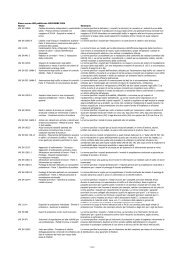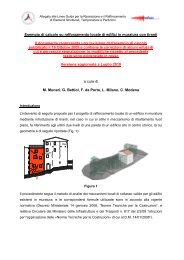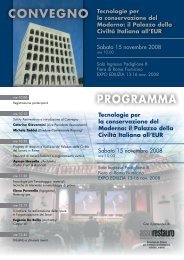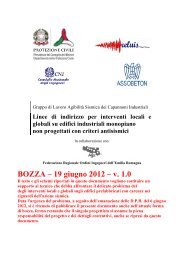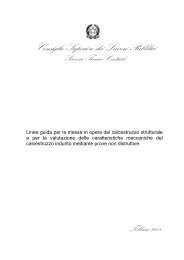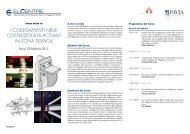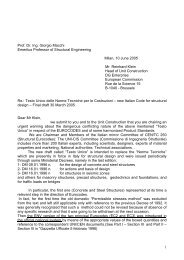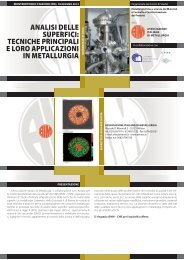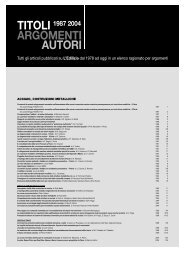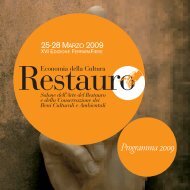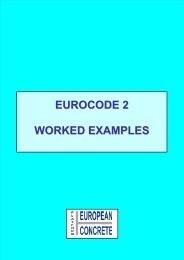Combinazioni di Verifica agli stati Limite: il non ... - Steelchecks.com
Combinazioni di Verifica agli stati Limite: il non ... - Steelchecks.com
Combinazioni di Verifica agli stati Limite: il non ... - Steelchecks.com
Create successful ePaper yourself
Turn your PDF publications into a flip-book with our unique Google optimized e-Paper software.
9<br />
affermazioni che oggi fanno sorridere chiunque abbia a che fare con modelli reali <strong>di</strong> strutture<br />
reali (tralasciamo gli esempietti usati per <strong>di</strong>mostrare una semplicità che <strong>non</strong> esiste).<br />
Non è dato sapere perché relativamente alla stessa equazione (1) la frase “questa equazione<br />
è simbolica e <strong>non</strong> è in generale <strong>di</strong>rettamente applicab<strong>il</strong>e” qui in Italia sia <strong>di</strong>ventata “si adotteranno<br />
le <strong>com</strong>binazioni espresse simbolicamente <strong>com</strong>e segue”: sarebbe interessante capirlo. Che senso ha<br />
<strong>di</strong>re “si adotteranno le <strong>com</strong>binazioni” facendo riferimento ad una formula errata<br />
2.3 Carichi variab<strong>il</strong>i nelle <strong>com</strong>binazioni relative ai carichi accidentali<br />
Consideriamo ora le <strong>com</strong>binazioni relative ai carichi accidentali, le (2). E’ da notare che <strong>il</strong><br />
coefficiente ψ 2i in alcuni casi può valere 0: questo avviene quando si assume nullo <strong>il</strong> valore quasi<br />
permanente <strong>di</strong> una certa azione. Se questo accade <strong>il</strong> corrispondente carico variab<strong>il</strong>e <strong>non</strong> è presente<br />
nel corso dell’azione accidentale. Per la normativa italiana questo è vero, ad esempio, per <strong>il</strong> vento.<br />
La presenza <strong>di</strong> un coefficiente ψ 2i nullo <strong>di</strong>minuisce <strong>il</strong> possib<strong>il</strong>e numero <strong>di</strong> <strong>com</strong>binazioni (2) da<br />
aggiungere a quelle <strong>di</strong> tipo (1). Alla base <strong>di</strong> ciò v’è <strong>il</strong> fatto che è molto improbab<strong>il</strong>e che l’evento<br />
accidentale massimo si verifichi in con<strong>com</strong>itanza con azioni variab<strong>il</strong>i in sé rare.<br />
E’ da notare che <strong>il</strong> coefficiente γ q è sparito: esso è implicitamente stato posto eguale a 1 per<br />
tutti i casi <strong>di</strong> carico variab<strong>il</strong>i, quin<strong>di</strong> <strong>di</strong> fatto è a fattor <strong>com</strong>une 5 . Ciò porta a scartare la possib<strong>il</strong>ità<br />
che una azione variab<strong>il</strong>e con effetto favorevole per qualche elemento strutturale abbia la ventura <strong>di</strong><br />
<strong>non</strong> esserci nel corso della azione eccezionale. Secondo la (2) ha da esserci per forza.<br />
Si tratta <strong>di</strong> una assunzione <strong>non</strong> a favore <strong>di</strong> sicurezza, che <strong>com</strong>pare anche nell’EC1, e che<br />
anche è stata confermata dalle recenti norme [4] (la ben nota “Or<strong>di</strong>nanza 3274” sulle costruzioni<br />
sismiche).<br />
Se si pensa ad esempio <strong>agli</strong> effetti <strong>di</strong> ribaltamento, si vede che la <strong>com</strong>pleta assenza <strong>di</strong> carichi<br />
variab<strong>il</strong>i che potrebbero essere stab<strong>il</strong>izzanti (<strong>com</strong>pleta assenza <strong>non</strong> prevista dalla (2)) può portare<br />
per qualche elemento strutturale a situazioni peggiori: era la <strong>com</strong>binazione <strong>di</strong> sisma+permanenti<br />
senza i variab<strong>il</strong>i, che sempre i progettisti in gamba prevedevano, perché a favore <strong>di</strong> sicurezza. Bene,<br />
tale <strong>com</strong>binazione è <strong>di</strong> fatto esclusa dalla (2), e <strong>non</strong> pare che questo sia corretto, perché sebbene una<br />
4 “Très souvent, dans le calcul, le nombre d’actions in<strong>di</strong>viduelles à considére est évident, et <strong>il</strong> sera rarement nécessaire<br />
de prendre en <strong>com</strong>pte plus de deux actions variables”.<br />
5 Si noti che questo vale anche per gli <strong>stati</strong> limite <strong>di</strong> servizio, dove sono ripetib<strong>il</strong>i ragionamenti analoghi sul problema<br />
del “fattor <strong>com</strong>une”.<br />
Paolo Rugarli – <strong>Combinazioni</strong> <strong>di</strong> <strong>Verifica</strong> <strong>agli</strong> <strong>stati</strong> <strong>Limite</strong>: <strong>il</strong> <strong>non</strong> detto delle Normative



